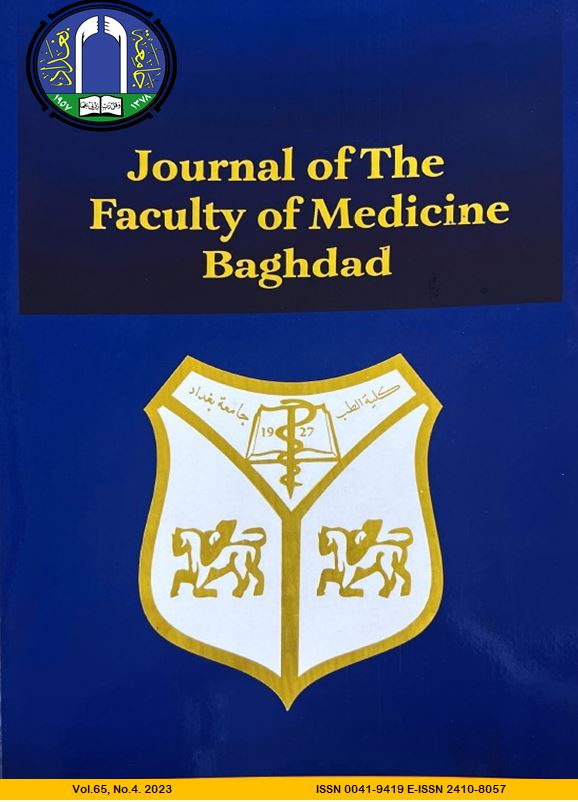Hypertransaminasemia: Incidence and its Clinical Correlations in Patients with COVID-19 Infection
DOI:
https://doi.org/10.32007/jfacmedbagdad.2123Keywords:
COVID-19 infection, Hepatic enzymes, Hypertrasaminasemia, Incidence, Liver injuryAbstract
Background: coronavirus-19 disease recently emerged as a global pandemic affecting the respiratory system. However, during the course of the illness, the disease can directly or indirectly involve other body organs including the liver.
Objectives: This study aimed to determine the incidence of hepatic involvement and its clinical significance in COVID-19 patients.
Patients and Methods: This cross-sectional single-center study was conducted on 112 patients who have an infection with Covid 19 (proved by polymerase chain reaction). Depending on infection severity, patients were categorized into three groups (according to the guidelines of the Chinese National Health Committee): mild, moderate, and severe cases. Blood samples were collected from each patient and liver function tests were conducted. Abnormal hepatic enzyme was considered when any enzyme (alanine transaminase, aspartate transaminase, and alkaline phosphatase) was more than the upper normal laboratory value. Categorical variables were presented as numbers and percentages and analyzed with a Chi-square test. A P≤ 0.05 was considered statistically significant.
Results: Sixty-six patients (58.93%) had normal liver enzymes, while the other 46 (41.07%) had abnormal liver enzymes. The mean age of patients with elevated liver enzymes was 45.17±11.93 years which was significantly higher than that of normal liver enzymes patients (38.92±13.47 years). In severe cases, 45.65% of patients had elevated liver enzyme compared with 43.48% in moderate group and 10.87 % in mild group.
Conclusions: Acute liver injury as indicated by hypertransaminasemia is a frequent finding in COVID-19 patients. Elderly patients with moderate to severe COVID-19 are more prone to hepatic involvement.
Received: May, 2022
Accepted: July, 2023
Published: Jan 2024
Downloads
References
Pawlotsky J. COVID-19 and the liver-related deaths to come. Nat Rev Gastroenterol Hapatol 2020; 10.1038 https://doi.org/10.1038/s41575-020-0328-2
Zhu N, Zhang D, Wang W, et al. A Novel Coronavirus from Patients with Pneumonia in China, 2019. N Engl J Med. 2020;382(8):727-733. https://doi.org/10.1056/NEJMoa2001017
Chen N, Zhou M, Dong X, et al. Epidemiological and clinical characteristics of 99 cases of 2019 novel coronavirus pneumonia in Wuhan, China: a descriptive study. The Lancet. 2020; 39:507-513.
https://doi.org/10.1016/S0140-6736(20)30211-7
Wang D, Hu B, Hu C, Zhu F, Liu X, J Z. Clinical Characteristics of 138 Hospitalized Patients with 2019 Novel Coronavirus-Infected Pneumonia in Wuhan, China. JAMA. 2020;323(11):1061-1069.
https://doi.org/10.1001/jama.2020.1585
Liu Y, Yang Y, Zhang C, et al. Clinical and biochemical indexes from 2019-nCoV infected patients linked to viral loads and lung injury. Sci China Life Sci. 2020A; 63(3):364-374.
https://doi.org/10.1007/s11427-020-1643-8
Shi H, Han X, Jiang N. Radiological findings from 81 patients with COVID-19 pneumonia in Wuhan, China: a descriptive study.. Lancet Infect Dis 2020;3099 (20)30086-4.
https://doi.org/10.1016/S1473-3099(20)30086-4
Liu F, Long X, Zou W, et al. Highly ACE2 expression in pancreas may cause pancreas damage after SARS-CoV-2 infection. Clin Gastroenterol Hepatol. 2020 Aug; 18(9):2128-2130.
https://doi.org/10.1016/j.cgh.2020.04.040
Fan Z, Chen L, Li J, et al. Clinical Features of COVID-19 related liver damage. Clin Gastroenterol Hepatol. 2020 Jun;18(7):1561-1566 https://doi.org/10.1016/j.cgh.2020.04.002
Zhang C, Shi L and Wang FS. Liver injury in COVID-19: Management and challenges. Lancet Gastroenterol Hepatol 2020; 5: 428-430. https://doi.org/10.1016/S2468-1253(20)30057-1
Li L, Li S, Xu M, et al. Risk factors related to hepatic injury in patients with corona virus disease 2019. medRxiv Preprint 10 March 2020: 2020.2002 https://doi.org/10.1101/2020.02.28.20028514
Alqahtani S, Schattenberg JM. Liver injury in COVID-19: the current evidence. United Eur Gastroenterol J 2020;8(5):511-519. https://doi.org/10.1177/2050640620924157
Yang Z, Xu M, Yi JQ, et al. Clinical characteristics and mechanism of liver damage in patients with severe acute respiratory syndrome. Hepatobiliary Pancreat Dis Int 2005; 4: 60-63.
Farcas GA, Poutanen SM, Mazzulli T, et al. Fatal severe acute respiratory syndrome is associated with multiorgan involvement by coronavirus. J Infect Dis 2005; 191:193-197
https://doi.org/10.1086/426870
Xu Z, Shi L, Wang Y, et al. Pathological findings of COVID-19 associated with acute respiratory distress syndrome.Lancet Respir Med 2020; 8: 420-422.https://doi.org/10.1016/S2213-2600(20)30076-X
Tirado SM, Yoon KJ. Antibody‐dependent enhancement of virus infection and disease. Viral Immunol. 2003;16(1):69‐86. https://doi.org/10.1089/088282403763635465
Wang SF, Tseng SP, Yen CH, et al. Antibody‐dependent SARS coronavirus infection is mediated by antibodies against spike proteins. Biochem Biophys Res Commun. 2014;451(2):208‐214.
https://doi.org/10.1016/j.bbrc.2014.07.090
Tian D, Ye Q. Hepatic complications of COVID-19 and its treatment. J Med Virol 2020; 10.1002/jmv.26036. https://doi.org/10.1002/jmv.26036
Yang X, Yu Y, Xu J, et al. Clinical course and outcomes of critically ill patients with SARS‐CoV‐2 pneumonia in Wuhan, China: a single centered retrospective, observational study. Lancet. Respir Med. 2020; 8(5):475-481. https://doi.org/10.1016/S2213-2600(20)30079-5
Görlach A, Dimova EY, Petry A, et al. Reactive oxygen species, nutrition, hypoxia and diseases: Problems solved?. Redox Biol. 2015; 6:372-385. https://doi.org/10.1016/j.redox.2015.08.016
Shehu AI, Lu J, Wang P, et al. Pregnane X receptor activation potentiates ritonavir hepatotoxicity. J Clin Invest. 2019;129(7): 2898‐2903.https://doi.org/10.1172/JCI128274
National Health Commission and State Administration of Traditional Chinese Medicine. Diagnosis and Treatment Protocol for Novel Coronavirus Pneumonia,(2020 : http://en.nhc.gov.cn/
Cai Q, Huang D, Yu H, et al.: COVID-19: abnormal liver function tests. J Hepatol. 2020;73(3):566-574. https://doi.org/10.1016/j.jhep.2020.04.006
Xie H, Zhao J, Lian N, et al: Clinical characteristics of non-ICU hospitalized patients with coronavirus disease 2019 and liver injury: a retrospective study. Liver Int 2020; 40(6):1321-1326. https://doi.org/10.1111/liv.14449
Zhang Y, Zheng L, Liu L, et al. Liver impairment in COVID-19 patients: A retrospective analysis of 115 cases from a single centre in Wuhan city, China. Liver Int. 2020 Sep;40(9):2095-2103.
https://doi.org/10.1111/liv.14455
Gholizadeh P, Safari R, Marofi P, et al. Alteration of Liver Biomarkers in Patients with SARS-CoV-2 (COVID-19). J Inflamm Res. 2020;13: 285-292. https://doi.org/10.2147/JIR.S257078
Omrani-Nava V , Maleki I, Ahmadi A, et al. Evaluation of Hepatic Enzymes Changes and Association with Prognosis in COVID-19 Patients, Hepat Mon. 2020; 20(4):e103179.
Downloads
Published
Issue
Section
License
Copyright (c) 2023 Rabah Asreah, Ali A. Al Hussein

This work is licensed under a Creative Commons Attribution 4.0 International License.












 Creative Commons Attribution 4.0 International license..
Creative Commons Attribution 4.0 International license..


